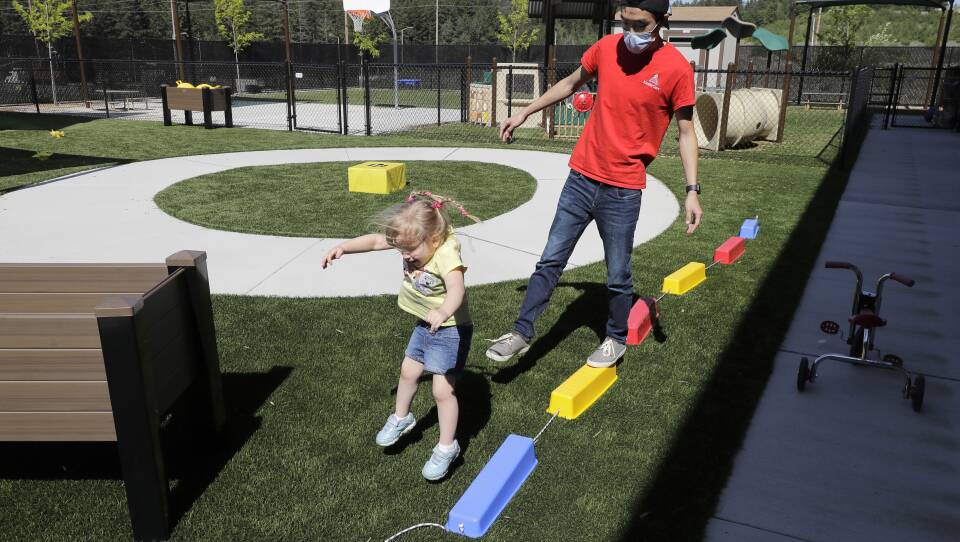With this year’s budget, state lawmakers will codify nearly half a billion dollars more in funding for child care providers than in the pre-pandemic era.
Massachusetts spun up a program known as C3 — Commonwealth Cares for Children — using federal pandemic relief dollars in 2021. It created an entirely new way of subsidizing child care in Massachusetts: providing direct grants to child care facilities to help with operational costs. Now, 9 in 10 providers take those grants to offset costs.And for this fiscal year, lawmakers are setting aside $475 million to support it.
“It signals this marriage of a financial and a policy commitment to a program that was a major change and augmentation to our early education system back a few years ago,” said Doug Howgate, the president of Massachusetts Taxpayers Foundation. “That’s a big deal.”
Surveys show, without the C3 funding, more than 20,000 child care seats would disappear across Massachusetts. But that federal funding has dried up. Last year, state legislators allocated one-time funding to fill that gap.
This year, the proposal — now on Gov. Maura Healey’s desk — will make it permanent as part of the annual budget.
It’s a major policy shift, but not one that’s likely to be felt on the ground. Swapping in one source of funding for another largely means that things will be holding steady.
Advocates with the Common Start Coalition — organizations across the state that have banded together to push for more affordable and equitable early education — applauded the move last week.
“Making the state’s C3 operational grant program for providers permanent will provide lasting support to Massachusetts’ early education and child care programs, allowing them to invest in educator compensation and increase their capacity to serve more children, while avoiding major cost increases for families,” Common Start Coalition Director Deb Fastino wrote in a statement.
Sharon MacDonald runs Guild of St. Agnes, a major child care agency in Worcester that cares for 2,000 children, and is pleased with the budget. She called the C3 reallocation “fabulous.” But after years of well-funded new programs fueled by federal pandemic relief dollars, this year’s revenue shortfalls also signaled a turn: “Christmas is over,” as MacDonald put it.
“It’s a good budget for early education and care — especially considering the cuts in other areas,” she said.
Hundreds of millions of dollars in funding would also carry on for the Department of Early Education and Childhood’s flagship subsidies: vouchers and contracted seats that are made available to families involved with the Department of Transitional Assistance, the Department of Children and Families, and families who make less than 50% of the state’s median income. About 60,000 children get subsidized child care through those programs, according to figures from the EEC.
But in an industry that’s chronically understaffed, the status quo is still difficult.
One of MacDonald’s priorities is hiring, and retaining, enough staff to fill classrooms. At many of her centers, she says, 20% to 40% of jobs go unfilled. That’s why she says it was “a little disappointing” to see rates for subsidized care increase only slightly, effectively translating to a 2% raise across seats that are paid for by the state.
“We haven’t seen a rate increase that low in years,” she said. “And those rate increases are what we use to pay our employees’ salary increases.”
Laura Valle-Gutierrez, a fellow at the New York–based progressive thinktank The Century Foundation, says that’s an issue she now sees at states across the country as federal funding has evaporated.
“Advocates raised the alarm that, without this funding, we’re going to start seeing prices go up for families,” she said. “It’s harder for providers to hire those early educators without bonuses, without those wage increases, that many providers only were able to give with the temporary stabilization funding.”
The budget also outlines that families at higher income levels should be eligible for vouchers and subsidies, moving the benchmark from $73,000 for a family of four to $124,000 or even higher. (That’s going from 50% of the state’s median income to 85%, a proposal carried over from an ambitious standalone bill approved in the Senate.)
But analysts say that’s an aspirational number, since the number of income-eligible families who actually receive the subsidy now is still a fraction of those who qualify.
“Theoretically we want to move to this much more expansive system,” Howgate said, explaining the budget proposal. “But it’s also saying: That is subject to the dollars we appropriated in the budget. And, until we get there, we’re going to focus on children who are already eligible, and maybe increasing that slightly.”








